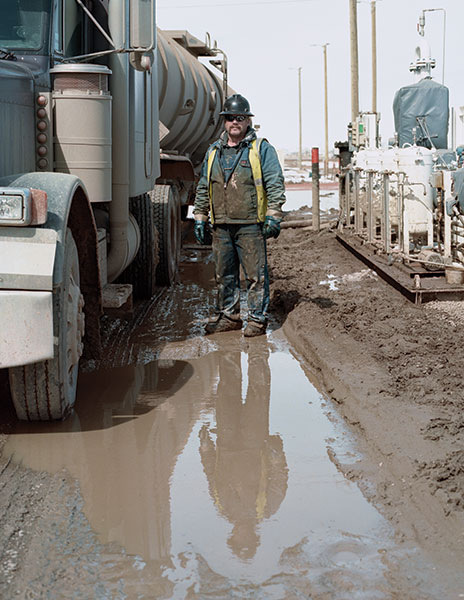Uncategorized
A formation: Adapting to life in the Bakken
Published
11 years agoon
Posted By
Outlaw PartnersA Formation: Adapting to Life in the Bakken Explorebigsky.com special presentation from Outlaw Partners on Vimeo.
Photos by Tyler Busby, Words by Joseph T. O’Connor, Videography by Chris Davis
They come for work. Waitresses, ex-cons, students, carpenters, strippers, oilmen. They seek promise in the Bakken, a new beginning, hope.
North Dakota, where much of the Bakken shale formation is located, ranks lowest among U.S. states in unemployment, at 3.3 percent, and second in oil production.
Longtime residents of Williston, Watford City, Glendive and Sidney – North Dakota and Montana towns in the Bakken formation – stay if they can, because it’s home. However that’s become increasingly difficult. An April 19, 2013 classified ad in the Williston Herald announced a three-bedroom home renting for $3,500 per month.
Mountain Outlaw sent a photographer, writer and videographer this spring to document the good, the bad and the ugly of an oil play, and to glean information on how Montana should prepare for what’s coming.
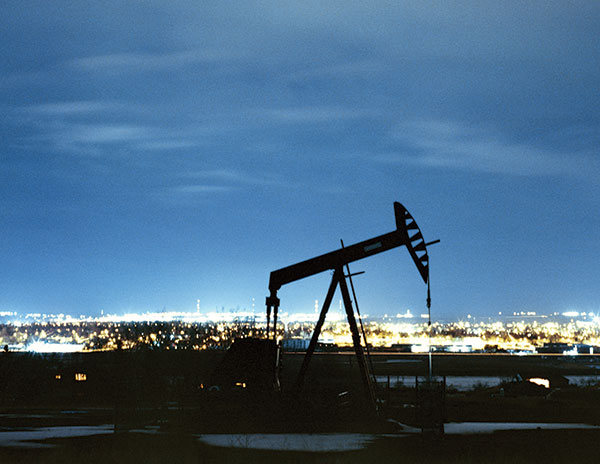

Pump jack east of Williston. The Williston Basin had 12,013 operating wells at the end of 2011, according to a study by Kadrmas, Lee and Jackson, Inc. released in October 2012. The basin, which includes the Bakken and Three Forks formations, spans 200,000 square miles and extends into parts of Montana, South Dakota and Saskatchewan, Canada. A U.S. Geological Survey report says there may be as many as 7.4 billion barrels of recoverable oil in the Bakken, though a 2012 Harvard Kennedy School study estimates 206 billion, noting that U.S. oil production could eclipse Saudi Arabia’s by 2020.
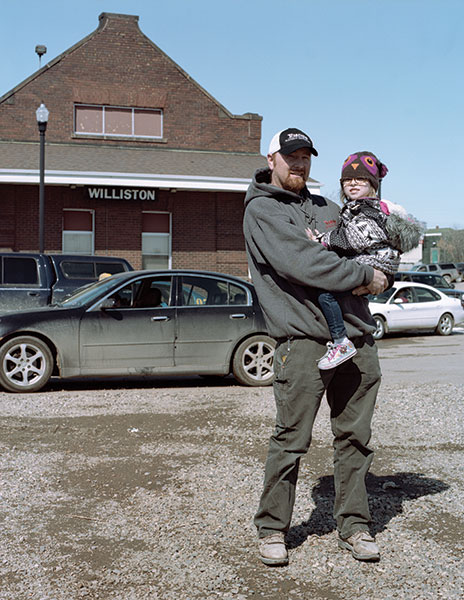

Jeffrey Strand and daughter Chyler. Williston native and farmer Jeffrey Strand, 35, waits for his wife with daughter Chyler, 4, at the city’s Amtrak station south of downtown. Strand, an electrician on the side in winter, started with Triangle Electric, Inc. in 1998 alongside 15 colleagues. Now, the company often has more than 300 contracted employees during a given week. “You used to know everybody driving by,” Strand said. “Now you just share the road with trucks.” In 2011, Williston’s Amtrak station saw 29,920 boardings. In 2012, that number jumped to 54,324.


Homeless. A man sleeps outside the Salvation Army Church at 15 Main Street in downtown Williston. Although many workers pull six-figure salaries, and Wal-Mart starting wages are $17 per hour, housing is scarce, and prices are high and rising. The Salvation Army is offering money toward one-way bus and train tickets out of the city for those unable to find housing. “Sometimes they realize the [oil fields] are a little rougher than they expected,” said Captain Joshua Stansbury, who along with his wife Rhegan are pastors and administrators at the Salvation Army’s Williston branch. “So, they realize it’s easier to go home.”
Kyle Huffman. Originally from Santa Rosa, California, Huffman, 25, arrived in the Bakken in 2011 and found a job on one of the hundreds of construction sites in the area. This April, Huffman was living with his girlfriend in Fairview, Montana. His car had broken down and two friends with a van picked him up and brought him to their lot at the Buffalo Trails R.V. Park on the north end of the city. The frigid North Dakota winters have taken their toll on his body, Huffman says. “I feel like I’ve aged 10 years.” But he knows the value of hard work. “Dad raised me old school. We’re in the Bakken [and] you gotta get everything yourself. It’s how it is.”
Glen Hong. Since 2009, Hong has driven his 379 Peterbilt oil tanker truck 700 miles from his home in Hamilton, Montana, to Williston, North Dakota, to work. On his three-week shifts, he picks up 220 barrels of crude and deposits them into storage tanks around the Bakken. On May 5, there were 618 job openings for tractor-trailer drivers, more than any other industry in Williston. On one day in 2011, the North Dakota Department of Transportation recorded 2,600 semis on Highway 85 between Williston and nearby Watford City.
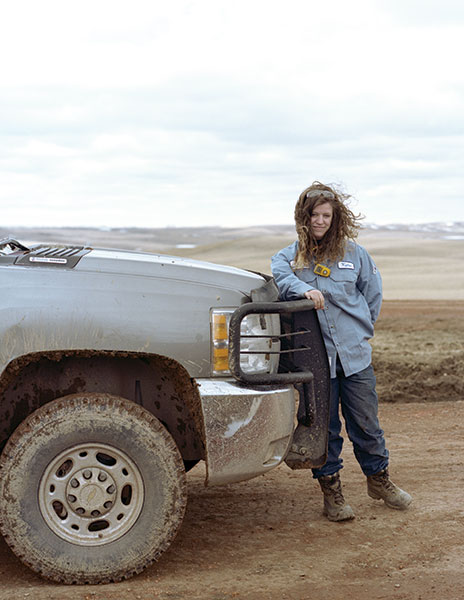

Kylee Karschner. Karschner, 21, arrived in Williston from Wellsboro, Pennsylvania on January 31. She was hired as a lab technician to collect water samples for a chemical company, but is now a mechanic for medium duty trucks and semis. She pays $1,100 in monthly rent for a 10×10 room in a house with three guys. She says the toughest part about being a woman in the oil patch is finding a good job with good pay. “Around here we’re not treated the same at entry-level positions.” And, she adds, “Don’t be by yourself after dark.” Reported male to female ratios in Williston range from 50-1, to 87-1.
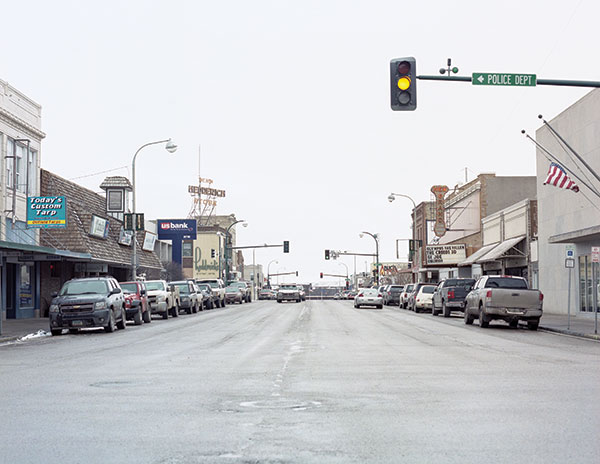

Williston, April 20, 2013. The intersection of Main and Broadway in downtown Williston is reminiscent of when the town was founded in 1887, save for the stoplights and major population increase. The 2000 census recorded 12,512 residents, the 2010 census, 14,716. But with temporary workers not registering vehicles or claiming residency, some estimates push those numbers as high as 80,000. This soaring growth has caused widespread increase in crime. From 2009 to 2010, calls to the Williston Police Department increased by 250 percent.
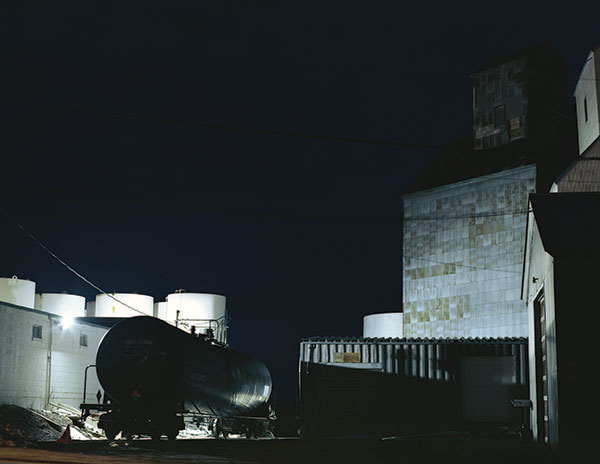

Grain elevator, railroad tank car. This defunct grain elevator near downtown Williston once held up to 100,000 bushels of grain, while tank cars can carry 34,500 gallons of crude. Drillers first struck oil in North Dakota on Clarence Iverson’s farm near Tioga on April 4, 1951, spurring the first oil boom in the Bakken. Montana hit oil that July. In the 1980s, oil boomed again. Then in 2004, with developments in hydraulic fracturing, wells began producing black gold in unprecedented amounts: the U.S. Energy Information Administration reports that in January 2013, 673,000 barrels of oil per day were extracted from the Bakken. According to a University of North Dakota study, amounts will peak at 1,200,000 bbl/d in 2022.


Ken Redman. Redman gazes through his kitchen window in Crane, Montana, between Glendive and Sidney, whose schools are reportedly bursting at the seams. Redman, 54, grew up farming and ranching in Montana, and has an agriculture degree from Montana State University-Bozeman and a M.A. from Colorado State University, but with a wife and three kids, he had to put food on the table. In agriculture, he says, “You break even if you do well.” In 2005, he became a directional oil driller with Baker Hughes. “The change is going to happen [in Montana]. How can we make it best for us?” The boom is over, Redman adds, indicating that oil-producing areas around the Bakken are seeing sustained growth: The formation could produce oil for the next 40 years.
The Outlaw Partners is a creative marketing, media and events company based in Big Sky, Montana.


You may like
Upcoming Events
april, 2024
Event Type :
All
All
Arts
Education
Music
Other
Sports
Event Details
Saturday, March 23rd 6:00-8:00pm We will combine the heart-opening powers of cacao with the transcendental powers of breathwork and sound. Together, these practices will give us the opportunity for a deep
more
Event Details
Saturday, March 23rd 6:00-8:00pm
Time
March 23 (Saturday) 6:00 pm - April 23 (Tuesday) 8:00 pm
Location
Santosha Wellness Center
169 Snowy Mountain Circle
Event Details
We all are familiar with using a limited palette, but do you use one? Do you know how to use a
more
Event Details
We all are familiar with using a limited palette, but do you use one? Do you know how to use a limited palette to create different color combinations? Are you tired of carrying around 15-20 different tubes when you paint plein air? Have you ever wanted to create a certain “mood” in a painting but failed? Do you create a lot of mud? Do you struggle to achieve color harmony? All these problems are addressed in John’s workbook in clear and concise language!
Based on the bestselling “Limited Palatte, Unlimited Color” workbook written by John Pototschnik, the workshop is run by Maggie Shane and Annie McCoy, accomplished landscape (acrylic) and plein air (oil) artists,exhibitors at the Big Sky Artists’ Studio & Gallery and members of the Big Sky Artists Collective.
Each student will receive a copy of “Limited Palette, Unlimited Color” to keep and take home to continue your limited palette journey. We will show you how to use the color wheel and mix your own clean mixtures to successfully create a mood for your paintings.
Each day, we will create a different limited palette color chart and paint a version of a simple landscape using John’s directives. You will then be able to go home and paint more schemes using the book for guidance.
Workshop is open to painters (oil or acrylic) of any level although students must have some basic knowledge of the medium he or she uses. Students will be provided the book ($92 value), color wheel, value scale and canvas papers to complete the daily exercises.
Sundays, April 14, 21 and 28, 2024
Noon until 6PM.
$170.
Time
14 (Sunday) 12:00 pm - 28 (Sunday) 6:00 pm
Event Details
Trivia from 7 to 9 p.m. at The Waypoint in Town Center. Participation is free, food and beverages available.
Event Details
Trivia from 7 to 9 p.m. at The Waypoint in Town Center. Participation is free, food and beverages available.
Time
(Wednesday) 7:00 pm - 9:00 pm
Location
The Waypoint
50 Ousel Falls Rd



